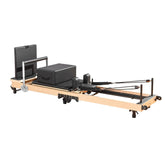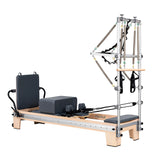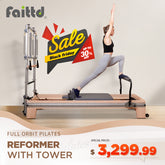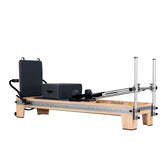Is Switching from Mat to Reformer Pilates Easy? Here’s What to Expect
Quick Answer
Yes, switching to Reformer Pilates is generally manageable for Mat Pilates practitioners, though it does come with a learning curve. If you're comfortable with Mat Pilates, you already understand the core principles and basic movements. Yes, there's new equipment to learn and you'll need a few classes to get the hang of the moving carriage, but most people feel more confident after 2-3 sessions and pretty comfortable within a month of regular practice.
Reformer vs Mat Pilates: Progress Timeline
| Stage | Reformer Pilates | Mat Pilates |
| Early Changes |
2-3 weeks Increased strength and stability from spring resistance |
3-4 weeks Improved posture and body awareness |
| Initial Results |
3-4 weeks Changes in clothing fit, especially core and thighs |
6-8 weeks Better core strength and stability |
| Visible Changes |
6-8 weeks Defined muscles in arms, legs, and abs |
10-12 weeks Noticeable physical changes with regular practice |
| Long-term Results |
3-4 months Significant muscle tone and body composition changes |
4-6 months Long, lean muscles and excellent posture |
*Based on consistent practice of 2-3 sessions per week
Reformer Pilates:
- Faster initial results (2-3 weeks) due to spring resistance system
- Primarily targets muscle definition and strength-building
- Shows visible body composition changes within the first month
- Achieves peak results in 3-4 months with consistent practice
Best for: Accelerated strength gains and muscle definition
Mat Pilates:
- Gradual progression starting at 3-4 weeks
- Focuses on foundational strength and postural alignment
- Develops lean muscle mass over a longer period
- Reaches optimal results in 4-6 months of regular practice
Best for: Long-term postural improvement and core stability
Key Difference: Pilates training on the reformers delivers faster visible results through resistance training, while Mat Pilates builds sustainable strength through bodyweight exercises.
How to Transition from Mat Pilates to Reformer Pilates

Recommended frequency: 2-3 sessions per week
1. Start with the Basics
Schedule a one-on-one session first. Your instructor will show you around the Reformer machine, help you find the right spring settings, and walk you through the essential moves. Think of it as your personal intro to the equipment – it'll make your next classes much more enjoyable!
2. Your First Week
Jump into two beginner classes to get comfortable. The Reformer might feel different from mat work, but that's normal! Pay attention to how your body feels and let your instructor know if something doesn't feel right. They're there to help you adjust.
3. Getting into the Groove (Weeks 2-4)
Now you can take 2-3 classes each week. You'll learn new moves and start feeling more at home on the machine – usually by your 6th or 8th class. Focus on getting the moves right rather than rushing into complicated exercises.
4. Finding Your Flow (After One Month)
Once basic moves feel natural, try some group classes. Many people enjoy mixing mat and Reformer sessions for variety. You'll notice you're stronger in both types of classes, and moving between them feels easy and fun.
Can You Go Straight Into Reformer Pilates?
Yes, you can start directly with Reformer Pilates, but it's not the most recommended approach for beginners. Most instructors advise taking 3-5 Mat Pilates classes first for optimal results and safety.
1. Safety First
Mat Pilates helps you understand fundamental Pilates principles, proper breathing techniques, and basic core engagement—essential skills that reduce injury risk on the Reformer.
2. Learning Curve
The Reformer equipment has multiple components and requires coordination to use properly. Having basic Pilates knowledge from mat work makes the transition to Reformer much smoother and more effective.
3. Best Practice Approach
- Start with 3-5 Mat Pilates classes
- Book a private Reformer session for a proper machine introduction
- Join small group Reformer classes (recommended 4-6 people maximum)
4. Exception Cases
You may start directly with Reformer Pilates if:
- You're working one-on-one with a certified instructor
- You have previous movement training (dance, gymnastics, yoga)
- Your physical therapist specifically recommends it

What to Expect When Moving from Mat to Reformer Pilates
1. You'll Work Against Spring Resistance Instead of Just Body Weight
Mat Pilates uses just your body weight, while the Reformer adds springs for an extra challenge. These springs can be adjusted from 1 to 16 pounds, letting you target specific muscles and increase difficulty as you get stronger. This means faster progress while maintaining that classic Pilates-toned look.
2. The Machine Helps You Perfect Your Form
The Reformer machine naturally guides your movements and shows when you're off-balance. Its sliding carriage tells you immediately if your form isn't right, helping you learn proper positioning faster than on a mat. Think of it as having a built-in form checker for every exercise.
3. You Get Many More Exercise Options Than Mat Work
The Reformer simply gives you more options. Instead of Mat Pilates' 50 basic moves, you get over 250 exercises to try. You can work out lying down, standing up, or kneeling, and even do cardio on the jump board. This variety keeps workouts interesting and works your body more completely.
Common Hurdles When Starting Reformer Pilates
- Equipment Intimidation: The Reformer's springs, straps, and moving parts can seem overwhelming at first, but most beginners feel comfortable with the basic setupof the reformers within 2-3 sessions.
- Coordination Challenges: Moving the carriage while maintaining proper form requires new coordination skills, which typically improve significantly after 6-8 classes of consistent practice.
- Spring Resistance Adjustment: Finding the right spring tension for different exercises takes time - beginners often use too much resistance, but instructors will help you adjust until you develop the feel for proper settings.
- Balance Insecurity: The moving carriage can make you feel unstable initially, but this actually helps develop deeper core strength and better balance over time.
- Timing and Flow: Transitioning smoothly between exercises on the Reformer takes practice, and most people master basic flow patterns within their first month of regular practice.
- Body Awareness: The Reformer highlights muscle imbalances and alignment issues more obviously than mat work, which can feel challenging but ultimately leads to better body awareness and form.
- Cost Concerns: Reformer classes typically cost 30-50% more than mat classes due to equipment and smaller class sizes, but many studios offer new client specials or class packages to make it more accessible.

Take Your First Step to Reformer Pilates Today
Yes, you'll invest more time and money at first, but the rewards are worth it—you'll build stronger muscles, stand taller, and understand your body better than ever. While buying your own Reformer machine (ranging from $2,000 to $8,000) might seem tempting for home practice, we recommend starting with studio classes first.
Once you're hooked and confident in your practice—typically after 3-6 months of regular sessions—you can better decide if a home Reformer makes sense for your lifestyle and budget. Why not browse local studios now and book that intro session? Your stronger, more confident self is just a phone call away.
FAQ
Q1: Is reformer Pilates more effective than mat?
Yes, Reformer Pilates is generally more effective for building strength and seeing faster results. The machine's spring resistance system allows for more targeted muscle work and provides greater exercise variety. While Mat Pilates builds excellent foundational strength, Reformer Pilates typically delivers quicker visible results in muscle tone and body composition.
Q2: Is Pilates harder with reformer?
Not necessarily. Reformer Pilates can actually be easier for beginners because the machine provides support and assistance. The springs help with balance and can make exercises more manageable for those with limited strength or flexibility. However, Reformer work can become more challenging as you progress by adjusting spring tensions and attempting more complex movements.
Q3: Does Reformer Pilates Burn More Calories Than Mat Pilates?
Yes, Reformer Pilates typically burns more calories than Mat Pilates. On average, a 60-minute Reformer session burns 350-450 calories, while a Mat Pilates class burns 200-300 calories. This higher calorie burn comes from the added resistance work and more dynamic movements on the Reformer machine.





